Module 11 Unit 2 Here are some ways to welcome them. 课件+嵌入音频(共30张PPT)
文档属性
| 名称 | Module 11 Unit 2 Here are some ways to welcome them. 课件+嵌入音频(共30张PPT) |
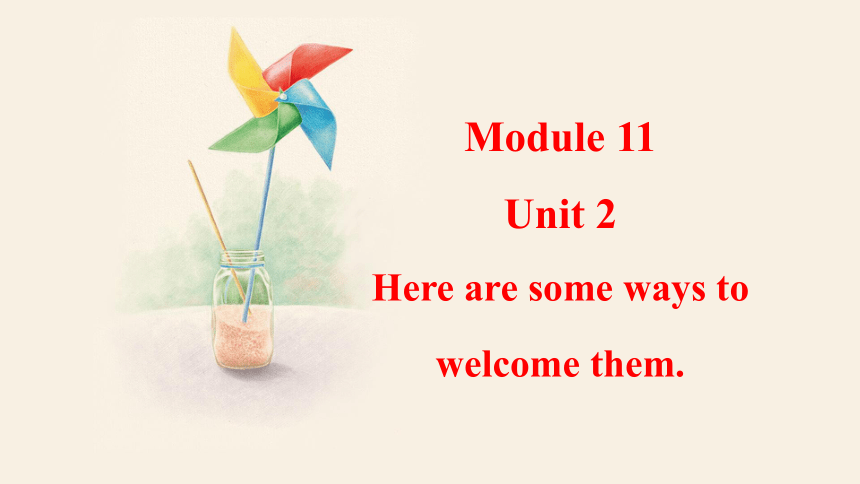
|
|
| 格式 | pptx | ||
| 文件大小 | 10.8MB | ||
| 资源类型 | 教案 | ||
| 版本资源 | 外研版 | ||
| 科目 | 英语 | ||
| 更新时间 | 2023-12-30 16:12:58 | ||
图片预览



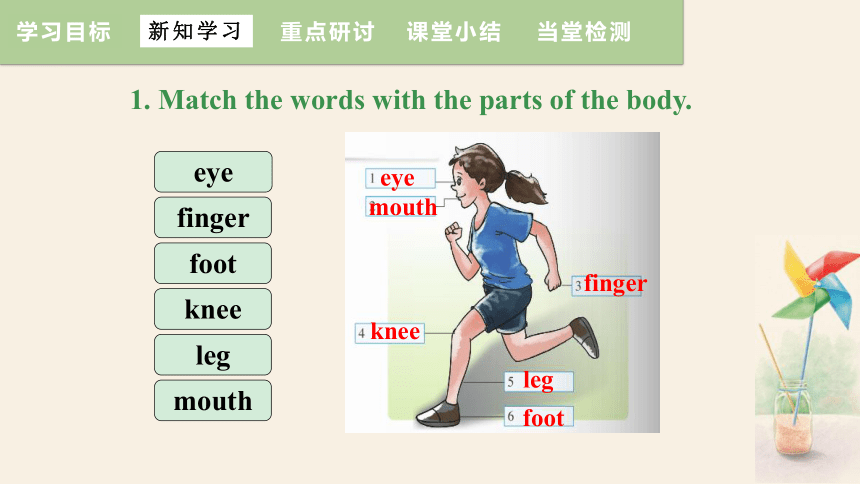
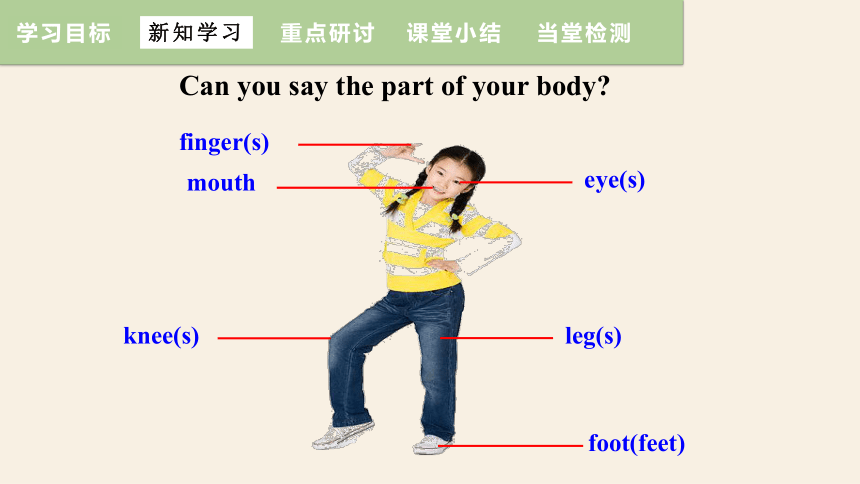
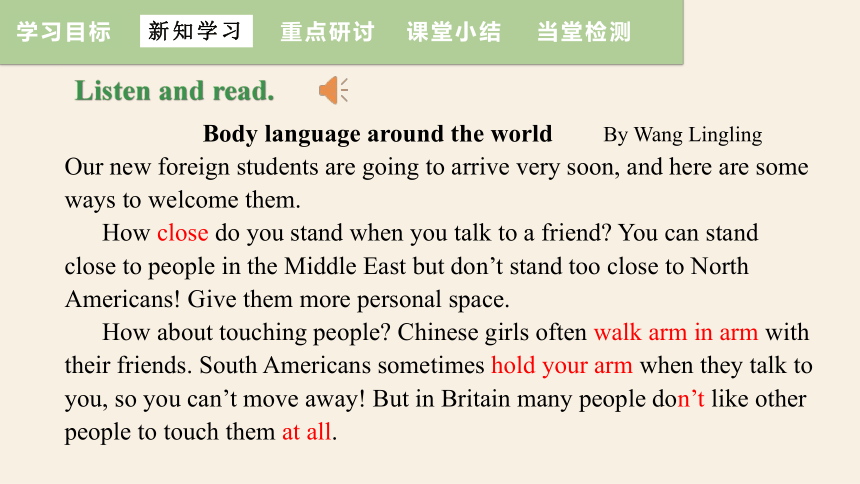
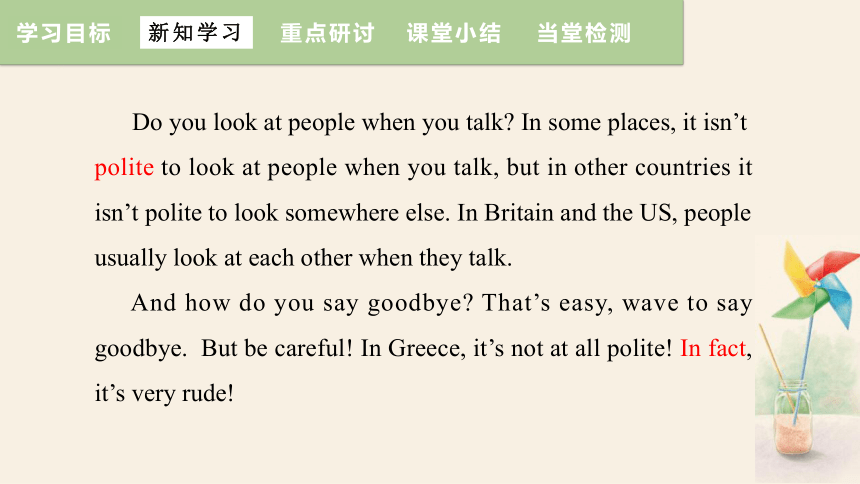
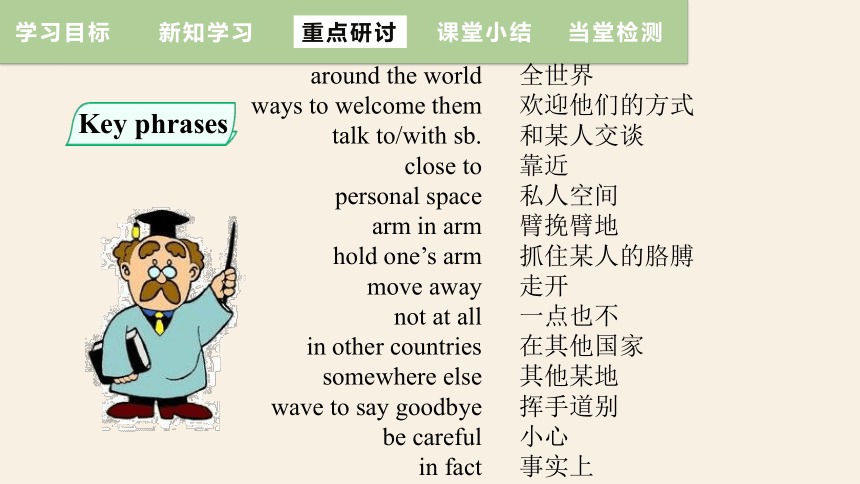
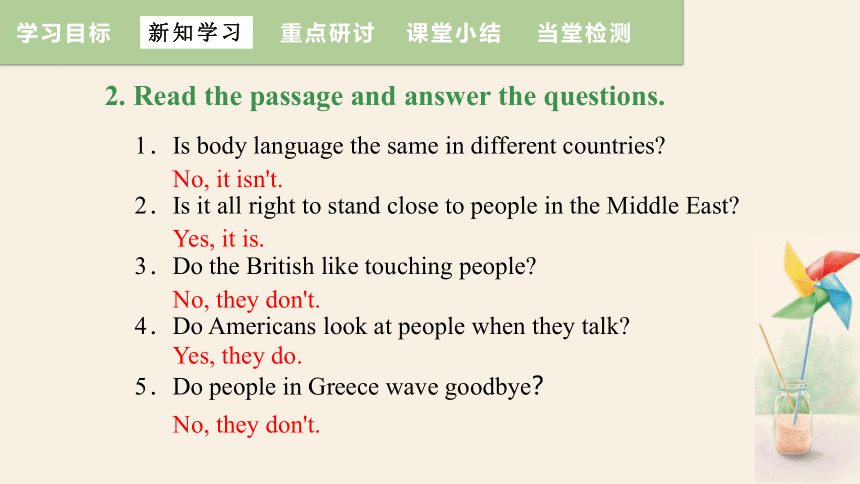
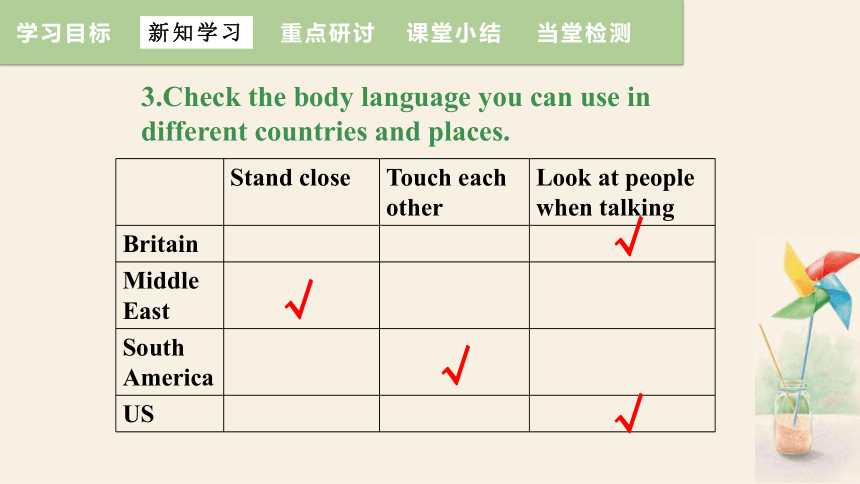
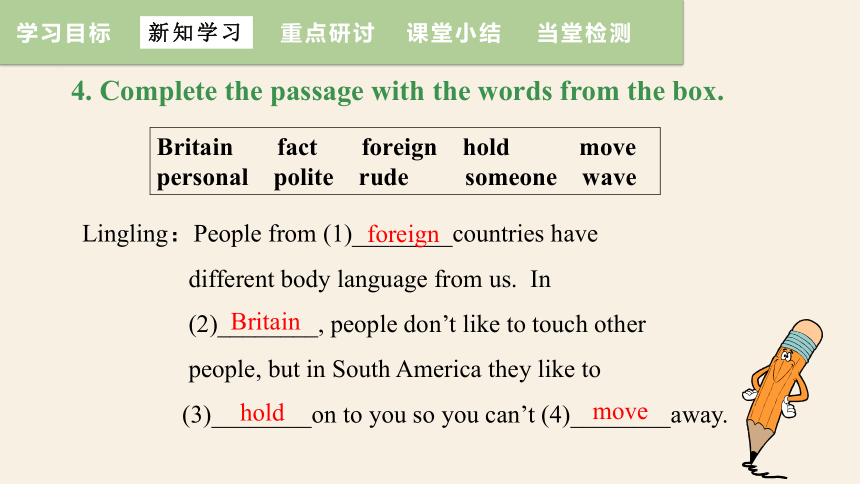
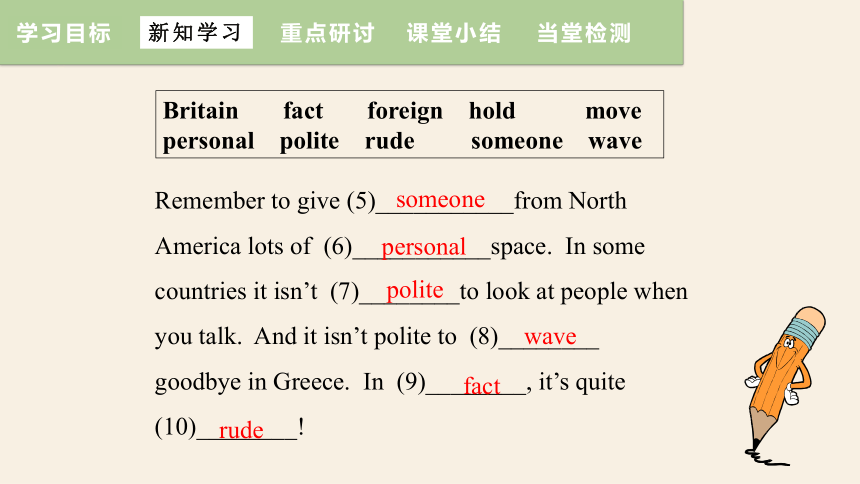
文档简介
(共30张PPT)
Module 11
Unit 2
Here are some ways to welcome them.
新
课
导
入
Language Goal
新知学习
课堂小结
当堂检测
学习目标
重点研讨
1. 能熟悉并能正确运用本课时出现的新单词和短语
2. 能够初步掌握祈使句的用法
新知学习
课堂小结
当堂检测
学习目标
重点研讨
1. Match the words with the parts of the body.
eye
finger
foot
knee
leg
mouth
eye
mouth
finger
knee
leg
foot
新知学习
课堂小结
当堂检测
学习目标
重点研讨
Can you say the part of your body
eye(s)
finger(s)
foot(feet)
knee(s)
leg(s)
mouth
新知学习
课堂小结
当堂检测
学习目标
重点研讨
Body language around the world By Wang Lingling
Our new foreign students are going to arrive very soon, and here are some ways to welcome them.
How close do you stand when you talk to a friend You can stand close to people in the Middle East but don’t stand too close to North Americans! Give them more personal space.
How about touching people Chinese girls often walk arm in arm with their friends. South Americans sometimes hold your arm when they talk to you, so you can’t move away! But in Britain many people don’t like other people to touch them at all.
Listen and read.
新知学习
课堂小结
当堂检测
学习目标
重点研讨
Do you look at people when you talk In some places, it isn’t polite to look at people when you talk, but in other countries it isn’t polite to look somewhere else. In Britain and the US, people usually look at each other when they talk.
And how do you say goodbye That’s easy, wave to say goodbye. But be careful! In Greece, it’s not at all polite! In fact, it’s very rude!
新知学习
课堂小结
当堂检测
学习目标
重点研讨
around the world
ways to welcome them
talk to/with sb.
close to
personal space
arm in arm
hold one’s arm
move away
not at all
in other countries
somewhere else
wave to say goodbye
be careful
in fact
全世界
欢迎他们的方式
和某人交谈
靠近
私人空间
臂挽臂地
抓住某人的胳膊
走开
一点也不
在其他国家
其他某地
挥手道别
小心
事实上
Key phrases
新知学习
课堂小结
当堂检测
学习目标
重点研讨
2. Read the passage and answer the questions.
1.Is body language the same in different countries
2.Is it all right to stand close to people in the Middle East
3.Do the British like touching people
4.Do Americans look at people when they talk
5.Do people in Greece wave goodbye?
No, it isn't.
Yes, it is.
No, they don't.
Yes, they do.
No, they don't.
新知学习
课堂小结
当堂检测
学习目标
重点研讨
3.Check the body language you can use in different countries and places.
Stand close Touch each other Look at people when talking
Britain
Middle East
South America
US
√
√
√
√
新知学习
课堂小结
当堂检测
学习目标
重点研讨
4. Complete the passage with the words from the box.
Lingling:People from (1)________countries have
different body language from us. In
(2)________, people don’t like to touch other
people, but in South America they like to
(3)________on to you so you can’t (4)________away.
Britain fact foreign hold move
personal polite rude someone wave
foreign
Britain
hold
move
新知学习
课堂小结
当堂检测
学习目标
重点研讨
Remember to give (5)___________from North America lots of (6)___________space. In some countries it isn’t (7)________to look at people when you talk. And it isn’t polite to (8)________ goodbye in Greece. In (9)________, it’s quite (10)________!
someone
personal
polite
wave
fact
rude
Britain fact foreign hold move
personal polite rude someone wave
新知学习
课堂小结
当堂检测
学习目标
重点研讨
5. Work in groups. Talk about your class rules.
—Shall we stand up when we answer a question in class
—Yes, we shall.
Writing
新知学习
课堂小结
当堂检测
学习目标
重点研讨
Shall we eat food in class
No, we shall not.
新知学习
课堂小结
当堂检测
学习目标
重点研讨
Stand up when you answer a question in class.
Don’t be late for class.
Be polite to the teacher.
Don’t eat food in class.
...
6. Make a list of class rules for new students in your school.
新知学习
课堂小结
当堂检测
学习目标
重点研讨
1.Don't take another student's things.
2.Don't push anyone when in line.
3.Don't shout.
4.Ask the teacher when you need to leave the class.
5.Walk quietly around the school.
6.Do what the teachers say the first time they ask.
7.Respect other students.
8.Be helpful to new students.
新知学习
课堂小结
当堂检测
学习目标
重点研讨
Language Points
1. Here are some ways to welcome them.
(1)here是表示“处所”的副词,表示“在这里”。常用在动词be之后, 作表语,表示“在/到这里”。主语可以是表特指的名词、代词、不定代词……等,有时也可用泛指性的名词词组。如:
Ann is not here.
安不在这里。
— Where is my shirt
— It’s here.
— 我的衬衫在哪里?
— 这里。
新知学习
课堂小结
当堂检测
学习目标
重点研讨
(2)肯定陈述句中, 这种“here”有时也可提前置于句首。主语若为名词,应引起倒装;主语若为人称代词,则“主谓”要用正常语序。这种提前主要是为了强调。
Here are some apples.
(相当于Some apples are here.)
这有一些苹果。
— Is it in your bag
— No, it isn’t. Oh, here it is.
— 它在你的包里吗?
— 不。哦,在这里。
(3)若主语为泛指性名词,还原正常语序时,应用“There be +主语+here”句型。
Here is an English book.
= There is an English book here.
= An English book is here.
这里有一本英语书。
新知学习
课堂小结
当堂检测
学习目标
重点研讨
2. How close do you stand when you talk to a friend
close /kl s/ adj. 靠近的;接近的
be close to靠近;stand close to 站得离……近
The post office _________________my home. 邮局离我家很近.
(1)close to 还可以表示情感、关系上“亲近的;亲密的”。
She _______________her grandma . 她和她奶奶很亲近。
(2)close还可作动词,意为“关;关闭”,其反义词为open。
Please _______ the window before leaving . 离开前请将窗户关上。
is close to
is close to
close
新知学习
课堂小结
当堂检测
学习目标
重点研讨
3. Give them more personal space.
personal adj. 私人的;个人的
Don’t question me about my personal business!
不要问我个人的私事!
Be careful how you start the personal computer.
要注意怎样启动个人计算机。
This is my personal problem.
这是我个人的问题。
4. How about touching people 碰触人怎么样
how about意为“……怎么样 ”是提建议的一种句式。
how about 的同义短语是what about。
how about 后接名词、代词或动词ing 形式。
例如:How about going shopping
表示提建议的句子还有:
Shall we do something Let's do something.
Would you like to do something
Why not do something
Why don't you do something
新知学习
课堂小结
当堂检测
学习目标
重点研讨
新知学习
课堂小结
当堂检测
学习目标
重点研讨
5. Chinese girls often walk arm in arm with their friends .
arm in arm意为“臂挽臂地”。
arm in arm 修饰动词,类似短语还有:
face to face面对面,
shoulder to shoulder肩并肩,
hand in hand手拉手。
They walked along the beach ________________.
他们臂挽臂沿着海滩散步。
arm in arm
新知学习
课堂小结
当堂检测
学习目标
重点研讨
6. South Americans sometimes hold your arm when they talk to you…
hold one’s arm 抓住某人的胳膊
hold 其他意思:
新知学习
课堂小结
当堂检测
学习目标
重点研讨
7. But in Britain many people don’t like other people to touch them at all.
not...at all 根本不,一点儿也不; not 与助词或be动词等构成句子否
定,at all 置于句末。She isn't happy at all. 她一点也不快乐。
辨析 not... at all与not at all
not ... at all 根本不, 一点儿也不 She can’t speak French at all.
她根本不会说法语。
not at all 不客气,不用谢 —Thank you very much.
非常感谢你。
—Not at all . 不用谢。
Not at all 用法小结:
用于回答感谢,意为“不用谢;不客气”。
A: Thanks for helping me.
谢谢你帮助我。
B: Not at all.
别客气。
A: Thank you very much.
非常感谢你。
B: Not at all.
不用谢。
2. 用于回答带有感谢性质的客套话,
意为“没什么;哪里哪里”。
A: You are very kind.
你真好。
B: Not at all.
没什么。
A: It’s very kind of you.
你真的是太好了!
B: Not at all.
哪里哪里。
新知学习
课堂小结
当堂检测
学习目标
重点研讨
新知学习
课堂小结
当堂检测
学习目标
重点研讨
8. But be careful! In Greece, it's not at all polite! In fact, it's very rude!
但是小心!在希腊,那绝对是不礼貌的!事实上,那很粗鲁!
in fact 为固定搭配,意为“事实上”。
fact 意为“事实,细节”。
Few people know the fact .
几乎没人知道这个事实。
In fact, I don’t know the girl. 事实上,我不认识这个女孩。
______ ______(事实上), he is afraid of singing in public .
In fact
新知学习
课堂小结
当堂检测
学习目标
重点研讨
polite /p 'la t/ adj . 礼貌的
polite 作形容词,其反义词为 impolite
Talking loudly in the library is impolite. 在图书馆大声说话是不礼貌的。
It is ________ (礼貌的) to offer seats to the old on the bus.
polite
It's not polite to do sth. 意为“做某事是不礼貌的”,it 是形式主语,真正的主语是to do sth.。
It's rude to do sth. 意为“做某事是粗鲁的”。
rude adj.粗鲁的,无礼的
Don’t be so rude to your parents! 别对你的父母这么没礼貌!
It is rude to spit in public.在公共场合吐痰是粗鲁的。
新知学习
重点研讨
课堂小结
当堂检测
学习目标
Module 11
Unit 2
重点单词:finger, foot, leg, mouth, body, knee, foreign, personal, arm, hold, move, polite, rude, wave, fact
重点短语:close to, how about... arm in arm, in fact, move away, personal space, not at all
重点句式: —Shall we stand up...—Yes, we shall.
How about touching people
Be polite to the teacher.
Don’t eat food in class.
新知学习
课堂小结
当堂检测
学习目标
重点研讨
1. We Chinese like to ______ (wave) to say goodbye.
2. When we arrived there, he was __________ (hold) a knife in his hand.
3. You should be ________ (有礼貌的) to the older.
4. I didn’t mean to be _______ (失礼的), but I have to leave early.
wave
holding
polite
rude
一、按照句子意思,填入恰当的词。
新知学习
课堂小结
当堂检测
学习目标
重点研讨
There are different kinds of_______ _________ around the world.
2. 事实上,这里的空气污染变得越来越严重了。
_______ _______, the air pollution here is getting more and more serious.
3. 丹尼一点儿也不喜欢放风筝。
Danny________like to fly kites_______ ________.
body language
In fact
doesn't at all
二、根据汉语完成句子
4. 我们臂挽臂沿着马路走。
We walk along the road .
5. 在过去,年轻人早晨应该向老年人问早安。
In the past, the young should ________ ________ ________ ________the old in the morning.
arm in arm
say good morning
to
1. 世界各地有不同种类的肢体语言。
Module 11
Unit 2
Here are some ways to welcome them.
新
课
导
入
Language Goal
新知学习
课堂小结
当堂检测
学习目标
重点研讨
1. 能熟悉并能正确运用本课时出现的新单词和短语
2. 能够初步掌握祈使句的用法
新知学习
课堂小结
当堂检测
学习目标
重点研讨
1. Match the words with the parts of the body.
eye
finger
foot
knee
leg
mouth
eye
mouth
finger
knee
leg
foot
新知学习
课堂小结
当堂检测
学习目标
重点研讨
Can you say the part of your body
eye(s)
finger(s)
foot(feet)
knee(s)
leg(s)
mouth
新知学习
课堂小结
当堂检测
学习目标
重点研讨
Body language around the world By Wang Lingling
Our new foreign students are going to arrive very soon, and here are some ways to welcome them.
How close do you stand when you talk to a friend You can stand close to people in the Middle East but don’t stand too close to North Americans! Give them more personal space.
How about touching people Chinese girls often walk arm in arm with their friends. South Americans sometimes hold your arm when they talk to you, so you can’t move away! But in Britain many people don’t like other people to touch them at all.
Listen and read.
新知学习
课堂小结
当堂检测
学习目标
重点研讨
Do you look at people when you talk In some places, it isn’t polite to look at people when you talk, but in other countries it isn’t polite to look somewhere else. In Britain and the US, people usually look at each other when they talk.
And how do you say goodbye That’s easy, wave to say goodbye. But be careful! In Greece, it’s not at all polite! In fact, it’s very rude!
新知学习
课堂小结
当堂检测
学习目标
重点研讨
around the world
ways to welcome them
talk to/with sb.
close to
personal space
arm in arm
hold one’s arm
move away
not at all
in other countries
somewhere else
wave to say goodbye
be careful
in fact
全世界
欢迎他们的方式
和某人交谈
靠近
私人空间
臂挽臂地
抓住某人的胳膊
走开
一点也不
在其他国家
其他某地
挥手道别
小心
事实上
Key phrases
新知学习
课堂小结
当堂检测
学习目标
重点研讨
2. Read the passage and answer the questions.
1.Is body language the same in different countries
2.Is it all right to stand close to people in the Middle East
3.Do the British like touching people
4.Do Americans look at people when they talk
5.Do people in Greece wave goodbye?
No, it isn't.
Yes, it is.
No, they don't.
Yes, they do.
No, they don't.
新知学习
课堂小结
当堂检测
学习目标
重点研讨
3.Check the body language you can use in different countries and places.
Stand close Touch each other Look at people when talking
Britain
Middle East
South America
US
√
√
√
√
新知学习
课堂小结
当堂检测
学习目标
重点研讨
4. Complete the passage with the words from the box.
Lingling:People from (1)________countries have
different body language from us. In
(2)________, people don’t like to touch other
people, but in South America they like to
(3)________on to you so you can’t (4)________away.
Britain fact foreign hold move
personal polite rude someone wave
foreign
Britain
hold
move
新知学习
课堂小结
当堂检测
学习目标
重点研讨
Remember to give (5)___________from North America lots of (6)___________space. In some countries it isn’t (7)________to look at people when you talk. And it isn’t polite to (8)________ goodbye in Greece. In (9)________, it’s quite (10)________!
someone
personal
polite
wave
fact
rude
Britain fact foreign hold move
personal polite rude someone wave
新知学习
课堂小结
当堂检测
学习目标
重点研讨
5. Work in groups. Talk about your class rules.
—Shall we stand up when we answer a question in class
—Yes, we shall.
Writing
新知学习
课堂小结
当堂检测
学习目标
重点研讨
Shall we eat food in class
No, we shall not.
新知学习
课堂小结
当堂检测
学习目标
重点研讨
Stand up when you answer a question in class.
Don’t be late for class.
Be polite to the teacher.
Don’t eat food in class.
...
6. Make a list of class rules for new students in your school.
新知学习
课堂小结
当堂检测
学习目标
重点研讨
1.Don't take another student's things.
2.Don't push anyone when in line.
3.Don't shout.
4.Ask the teacher when you need to leave the class.
5.Walk quietly around the school.
6.Do what the teachers say the first time they ask.
7.Respect other students.
8.Be helpful to new students.
新知学习
课堂小结
当堂检测
学习目标
重点研讨
Language Points
1. Here are some ways to welcome them.
(1)here是表示“处所”的副词,表示“在这里”。常用在动词be之后, 作表语,表示“在/到这里”。主语可以是表特指的名词、代词、不定代词……等,有时也可用泛指性的名词词组。如:
Ann is not here.
安不在这里。
— Where is my shirt
— It’s here.
— 我的衬衫在哪里?
— 这里。
新知学习
课堂小结
当堂检测
学习目标
重点研讨
(2)肯定陈述句中, 这种“here”有时也可提前置于句首。主语若为名词,应引起倒装;主语若为人称代词,则“主谓”要用正常语序。这种提前主要是为了强调。
Here are some apples.
(相当于Some apples are here.)
这有一些苹果。
— Is it in your bag
— No, it isn’t. Oh, here it is.
— 它在你的包里吗?
— 不。哦,在这里。
(3)若主语为泛指性名词,还原正常语序时,应用“There be +主语+here”句型。
Here is an English book.
= There is an English book here.
= An English book is here.
这里有一本英语书。
新知学习
课堂小结
当堂检测
学习目标
重点研讨
2. How close do you stand when you talk to a friend
close /kl s/ adj. 靠近的;接近的
be close to靠近;stand close to 站得离……近
The post office _________________my home. 邮局离我家很近.
(1)close to 还可以表示情感、关系上“亲近的;亲密的”。
She _______________her grandma . 她和她奶奶很亲近。
(2)close还可作动词,意为“关;关闭”,其反义词为open。
Please _______ the window before leaving . 离开前请将窗户关上。
is close to
is close to
close
新知学习
课堂小结
当堂检测
学习目标
重点研讨
3. Give them more personal space.
personal adj. 私人的;个人的
Don’t question me about my personal business!
不要问我个人的私事!
Be careful how you start the personal computer.
要注意怎样启动个人计算机。
This is my personal problem.
这是我个人的问题。
4. How about touching people 碰触人怎么样
how about意为“……怎么样 ”是提建议的一种句式。
how about 的同义短语是what about。
how about 后接名词、代词或动词ing 形式。
例如:How about going shopping
表示提建议的句子还有:
Shall we do something Let's do something.
Would you like to do something
Why not do something
Why don't you do something
新知学习
课堂小结
当堂检测
学习目标
重点研讨
新知学习
课堂小结
当堂检测
学习目标
重点研讨
5. Chinese girls often walk arm in arm with their friends .
arm in arm意为“臂挽臂地”。
arm in arm 修饰动词,类似短语还有:
face to face面对面,
shoulder to shoulder肩并肩,
hand in hand手拉手。
They walked along the beach ________________.
他们臂挽臂沿着海滩散步。
arm in arm
新知学习
课堂小结
当堂检测
学习目标
重点研讨
6. South Americans sometimes hold your arm when they talk to you…
hold one’s arm 抓住某人的胳膊
hold 其他意思:
新知学习
课堂小结
当堂检测
学习目标
重点研讨
7. But in Britain many people don’t like other people to touch them at all.
not...at all 根本不,一点儿也不; not 与助词或be动词等构成句子否
定,at all 置于句末。She isn't happy at all. 她一点也不快乐。
辨析 not... at all与not at all
not ... at all 根本不, 一点儿也不 She can’t speak French at all.
她根本不会说法语。
not at all 不客气,不用谢 —Thank you very much.
非常感谢你。
—Not at all . 不用谢。
Not at all 用法小结:
用于回答感谢,意为“不用谢;不客气”。
A: Thanks for helping me.
谢谢你帮助我。
B: Not at all.
别客气。
A: Thank you very much.
非常感谢你。
B: Not at all.
不用谢。
2. 用于回答带有感谢性质的客套话,
意为“没什么;哪里哪里”。
A: You are very kind.
你真好。
B: Not at all.
没什么。
A: It’s very kind of you.
你真的是太好了!
B: Not at all.
哪里哪里。
新知学习
课堂小结
当堂检测
学习目标
重点研讨
新知学习
课堂小结
当堂检测
学习目标
重点研讨
8. But be careful! In Greece, it's not at all polite! In fact, it's very rude!
但是小心!在希腊,那绝对是不礼貌的!事实上,那很粗鲁!
in fact 为固定搭配,意为“事实上”。
fact 意为“事实,细节”。
Few people know the fact .
几乎没人知道这个事实。
In fact, I don’t know the girl. 事实上,我不认识这个女孩。
______ ______(事实上), he is afraid of singing in public .
In fact
新知学习
课堂小结
当堂检测
学习目标
重点研讨
polite /p 'la t/ adj . 礼貌的
polite 作形容词,其反义词为 impolite
Talking loudly in the library is impolite. 在图书馆大声说话是不礼貌的。
It is ________ (礼貌的) to offer seats to the old on the bus.
polite
It's not polite to do sth. 意为“做某事是不礼貌的”,it 是形式主语,真正的主语是to do sth.。
It's rude to do sth. 意为“做某事是粗鲁的”。
rude adj.粗鲁的,无礼的
Don’t be so rude to your parents! 别对你的父母这么没礼貌!
It is rude to spit in public.在公共场合吐痰是粗鲁的。
新知学习
重点研讨
课堂小结
当堂检测
学习目标
Module 11
Unit 2
重点单词:finger, foot, leg, mouth, body, knee, foreign, personal, arm, hold, move, polite, rude, wave, fact
重点短语:close to, how about... arm in arm, in fact, move away, personal space, not at all
重点句式: —Shall we stand up...—Yes, we shall.
How about touching people
Be polite to the teacher.
Don’t eat food in class.
新知学习
课堂小结
当堂检测
学习目标
重点研讨
1. We Chinese like to ______ (wave) to say goodbye.
2. When we arrived there, he was __________ (hold) a knife in his hand.
3. You should be ________ (有礼貌的) to the older.
4. I didn’t mean to be _______ (失礼的), but I have to leave early.
wave
holding
polite
rude
一、按照句子意思,填入恰当的词。
新知学习
课堂小结
当堂检测
学习目标
重点研讨
There are different kinds of_______ _________ around the world.
2. 事实上,这里的空气污染变得越来越严重了。
_______ _______, the air pollution here is getting more and more serious.
3. 丹尼一点儿也不喜欢放风筝。
Danny________like to fly kites_______ ________.
body language
In fact
doesn't at all
二、根据汉语完成句子
4. 我们臂挽臂沿着马路走。
We walk along the road .
5. 在过去,年轻人早晨应该向老年人问早安。
In the past, the young should ________ ________ ________ ________the old in the morning.
arm in arm
say good morning
to
1. 世界各地有不同种类的肢体语言。
同课章节目录
- Module 1 Lost and found
- Unit 1 Whose bag is this?
- Unit 2 Are they yours?
- Unit 3 Language in use
- Module 2 What can you do ?
- Unit 1 I can play the piano
- Unit 2 I can run really fast
- Unit 3 Language in use
- Module 3 Making plans
- Unit 1 What are you going to do at the weekends?
- Unit 2 We're going to cheer the players.
- Unit 3 Language in use
- Module 4 Life in the future
- Unit 1 Everyone will study at home
- Unit 2 Every family will have a small plane.
- Unit 3 Language in use
- Module 5 Shopping
- Unit 1 What can I do for you?
- Unit 2 You can buy everything on the Internet
- Unit 3 Language in use
- Module 6 Around town
- Unit 1 Could you tell me how to get to the Nationa
- Unit 2 The London Eye is on your right.
- Unit 3 Language in use
- Revision module A
- Module 7 My past life
- Unit 1 I was born in a small village.
- Unit 2 I was born in Quincy.
- Unit 3 Language in use
- Module 8 Story time
- Unit 1 Once upon a time….
- Unit 2 Goldilocks hurried out of the house.
- Unit 3 Language in use
- Module 9 Life history
- Unit 1 He left school and began work at the age of
- Unit 2 He decided to be an actor.
- Unit 3 Language in use
- Module 10 A holiday journey
- Unit 1 What did you do?
- Unit 2 This morning we took a walk.
- Unit 3 Language in use
- Module 11 Body language
- Unit 1 They touch noses!
- Unit 2 Here are some ways to welcome them.
- Unit 3 Language in use
- Module 12 Western music
- Unit 1 It's so beautiful!
- Unit 2 Vienna is the centre of European classical
- Unit 3 Language in use
- Revision module B
